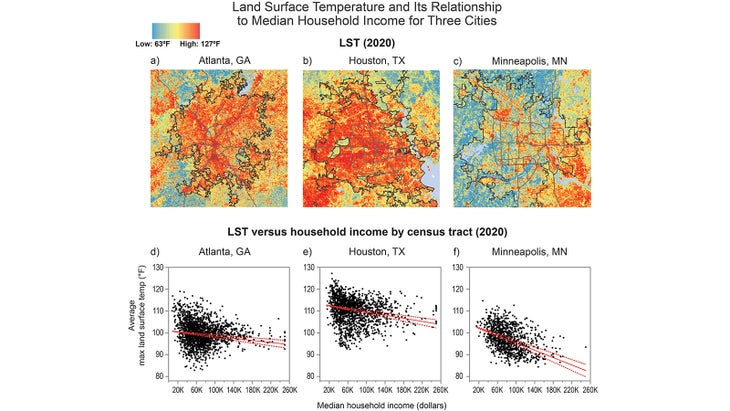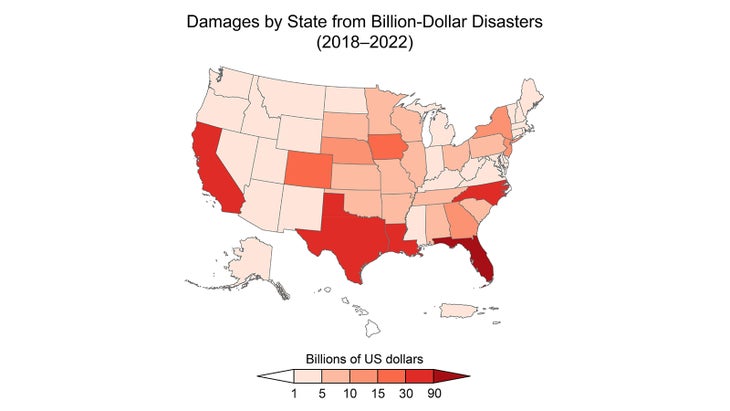No products in the cart.
Outdoor Adventure
Congress Won’t Touch the Climate Disaster. How is President Biden Intervening?
The Fifth National Climate Assessment—released by the White House this week—provides a formal, scientific conclusion to back up the events we’ve all lived through in 2023: The climate disaster is here; it’s already killing tens of thousands of people; it’s already costing hundreds of billions of dollars; and it’s going to get worse. But not all hope is lost—there’s one more finding: It’s not too late to do something about it.
But, preparing our infrastructure for more extreme weather, spinning up new sectors of the economy to move us away from fossil fuels, and protecting the natural systems that can insulate us from the climate disaster’s worst requires two things: legislation and funding. And laws and budgets are written by Congress. There, a Republican majority in the House of Representatives has made that chamber deeply dysfunctional, while a narrow Democratic majority in the Senate has put an inordinate amount of power in the hands of politicians heavily invested in continuing to destroy our planet’s ability to support human life.
Meanwhile, a Supreme Court packed with religious zealots during the Trump administration has busied itself with the work of rolling back environmental protections our country has enjoyed since as far back as the Nixon presidency. Last year, the court restricted the Environmental Protection Agency’s ability to regulate carbon emissions. This May, they stripped Clean Water Act protections from 50 percent of all streams in the lower 48, and 110 million acres of wetlands. Next year, the court will rule on the ability of federal agencies to create their own interpretations of statutes they administer, potentially moving all regulatory decision-making to Congress, which can’t even agree on an annual budget, let alone anything else.
That leaves only the Executive branch, which has the power only to implement legislation and budgets Congress passes, and which the Supreme Court hasn’t deemed illegal. As the last bastion of competence and forward-thinking left at the federal level, is the Biden administration able to look at the conclusions in the Assessment, and take any meaningful action in addressing them?
That’s the goal of $6 billion of new spending the White House is announcing alongside the assessment’s release. It’s drawn from both the Inflation Reduction Act and Bipartisan Infrastructure Law and works within the boundaries of that legislation to find new solutions to specific problems identified in the assessment.
“Anyone who willfully denies the impact of climate change is condemning the American people to a very dangerous future,” states President Biden. Here’s how his administration is spending that money to build a safer one.
America’s Aging Energy Grid
The problem: Our ability to distribute electrical power is being put at risk by more extreme weather events. This not only leads to power failures during high winds and heat waves, but those failures can start wildfires, creating their own disasters. Existing infrastructure is also not up to the task of handling new power demands created by the shift towards electrical vehicles, or working with renewable energy sources.
“Aging energy grids are expected to be strained by disruptions and transmission efficiency losses from climate change,” reads the assessment’s summary.
The solution: The Department of Energy is applying $3.9 billion in new spending to help strengthen and modernize the grid. This comes on top of an existing $3.46 billion investment, both drawn from Bipartisan Infrastructure Law funding. This money will be distributed in grant form through the Grid Resilience and Innovation Partnerships program and is available to entities ranging from higher education to electrical grid operators. The goal is to both shore up existing grid infrastructure to make it more reliable through extreme weather and less likely to cause wildfires while developing and implementing new technologies that will expand the grid’s capacity to handle EV charging and distribute power from renewable sources.
“Grid managers are gaining experience planning and operating electricity systems with growing shares of renewable generation and working toward understanding the best approaches for dealing with the natural variability of wind and solar sources alongside increases in electrification,” the assessment reads. “Grid expansion and energy efficiency efforts are already creating new jobs in places like Nevada, Vermont, and Alaska.”

The Climate Disaster’s Worst Impacts are being Felt by Disadvantaged Communities and People of Color
The problem: Decades of under-investment in poorer communities has left them facing disproportionate impacts from emissions caused predominantly by wealthier Americans. This has left communities ill-prepared for extreme weather, and people experiencing a multitude of negative health outcomes.
“An equitable and sustainable US response to climate change has the potential to reduce climate impacts while improving well-being, strengthening resilience, benefiting the economy, and, in part, redressing legacies of racism and injustice,” reads the assessment.
The solution: The transformational size of the investment required to mitigate the climate disaster also provides the opportunity to address historic injustices and enable more people to more fully participate in the American economy, growing markets and benefiting everyone. There’s also an opportunity to tap into underutilized systems and solutions such as Indigenous Knowledge.
The Environmental Protection Agency will make $2 billion in Inflation Reduction Act money available as part of the Environmental Justice and Community Change Grants program to support community-driven clean energy projects, and support improvements in resilience to extreme weather.
“Indigenous Peoples are leading numerous actions in response to climate change, including planning and policy initiatives, youth movements, cross-community collaborative efforts, and the expansion of renewable energy,” the assessment finds. “Many of these efforts involve planning processes that start with place-based Indigenous Knowledge of local climate and ecosystems.”

Infrastructure and Communities are being Devastated by Flooding
The problem: Rainfall is becoming more extreme and unpredictable, increasing flooding risks and bringing floods to places that haven’t historically experienced them.
“More rain falls during the most extreme precipitation events,” finds the assessment.
The solution: More investment is needed in hardening or relocating homes, businesses, and infrastructure to adapt to increased flood risk, even as more money is required to rebuild from ongoing flooding events.
The Federal Emergency Management Agency is adding $300 million to its Swift Current Initiative, drawn from the Bipartisan Infrastructure Law. This will help communities recover from flooding experienced in recent years, while also shifting reconstruction efforts away from areas at risk from floods or rebuilding in a more robust manner.
These investments will help make the economy, and food supply more resilient. For example, the assessment finds, “Between 1981 and 2016, US corn yield losses from flooding were comparable to those from extreme drought.”
Huge Capital Investments Are At Risk
The problem: Drought in western states is threatening drinking water supplies and hydropower generation even as the populations there boom. Sea level rise, ocean acidification, shifting rainfall patterns, and extreme weather are damaging native Hawaiian communities. And the climate disaster is impacting national security assets and infrastructure.
“Strategic planning and investment in resilience can reduce the economic impacts of climate change, including costs to households and businesses, risks to markets and supply chains, and potential negative impacts on employment and income, while also providing opportunities for economic gain,” the assessment concludes.
The solution: As larger investments in infrastructure and communities take place, it makes sense to look at the likely impacts from climate change, and prepare for them. But doing so requires research and planning tools that may not currently exist, or which require expansion or accessibility in order to be useful to stakeholders.
The Department of the Interior is applying the $100 million Bipartisan Infrastructure Law funding in a grant program soliciting water infrastructure resilience, water conservation, and hydropower upgrade projects. In Hawaii, $20 million in Inflation Reduction Act money for the newly-announced Kapapahuliau Climate Resilience Program will help native communities adapt. The Department of Defense is launching a new web portal that will help service members identify risk factors as they plan security investments. The White House is also taking it upon itself to serve as a hub for resilience knowledge, hosting summits and publishing insights that will help planners nationwide create more resilient investments.
“Forward-looking designs of infrastructure and services can help build resilience to climate change, offset costs from future damage to transportation and electrical systems, and provide other benefits, including meeting evolving standards to protect public health, safety, and welfare,” finds the assessment.

Critical Ecosystems Are Threatened
The problem: Natural ecosystems like wetlands and forests are essential to our nation’s climate resilience, but are also threatened not only by climate change, but other human activity as well.
“Ongoing drought amplified the record-breaking Pacific Northwest heatwave of June 2021, which was made 2° to 4°F hotter by climate change. The heatwave led to more than 1,400 heat-related deaths, another severe wildfire season, mass die-offs of fishery species important to the region’s economy and Indigenous communities, and total damages exceeding $38.5 billion (in 2022 dollars),” the assessment cites as one example.
The solution: Investing in conserving natural resources is essential to adapting to the climate disaster, and holds many other benefits from mental health to shoring up local economies.
The Department of Interior plans to spend $166 million from the Infrastructure Reduction Act on ecosystem resilience in National Parks over the next nine years, adding to $44 million in funding already put in place by the Biden administration. A public-private partnership is also providing $140 million in grant money for Biden’s America the Beautiful Challenge, which aims to conserve 30 percent of American lands and waters by 2030. That money will fund 74 different programs spread across 46 states, three U.S. territories, and 21 tribal nations.
“Nature-based solutions that restore degraded ecosystems and preserve or enhance carbon storage in natural systems like forests, oceans, and wetlands, as well as agricultural lands, are cost-effective mitigation strategies, finds the report. “For example, with conservation and restoration, marine and coastal ecosystems could capture and store enough atmospheric carbon each year to offset about 3% of global emissions (based on 2019 and 2020 emissions). Many nature-based solutions can provide additional benefits, like improved ecosystem resilience, food production, improved water quality, and recreational opportunities.”

The Scale of the Climate Disaster is Matched By Its Opportunity
Ultimately, even $6 billion isn’t going to be nearly enough money to address the problems identified in the Fifth National Climate Assessment. In addition to closing critical gaps in our national preparedness, what the Biden administration is trying to achieve here is a demonstration that investing in adaptation, resilience, and emissions reduction is also smart business.
Just over a year in, the $740 billion Inflation Reduction Act—the largest investment in clean energy ever—has already attracted $110 billion in private investment and created 170,000 high-paying jobs in the clean energy sector, while lowering electricity bills across American households. Two years later, the $1.2 trillion Bipartisan Infrastructure Law has helped to create 670,00 new jobs in construction, many on projects designed to improve climate resilience. Competent governance works, even in a time of crisis.
“It shows us that climate action offers an opportunity for the nation to come together and do some really big things,” states President Biden.
Source link

